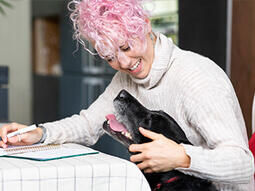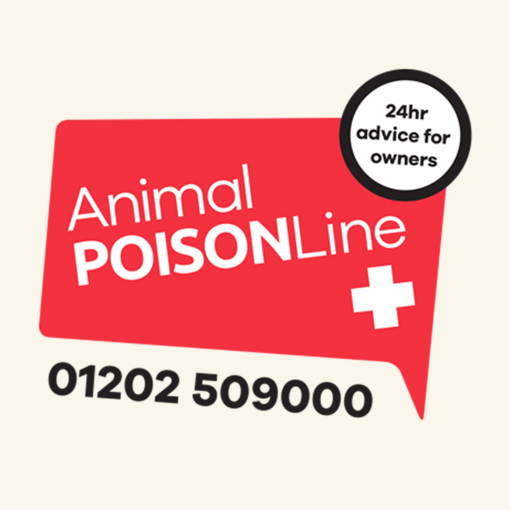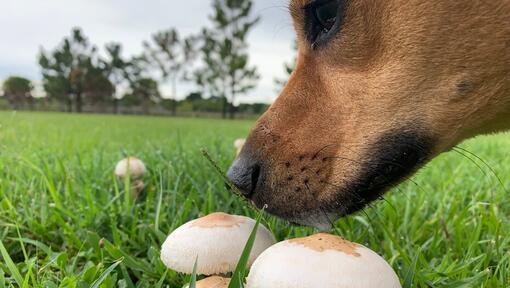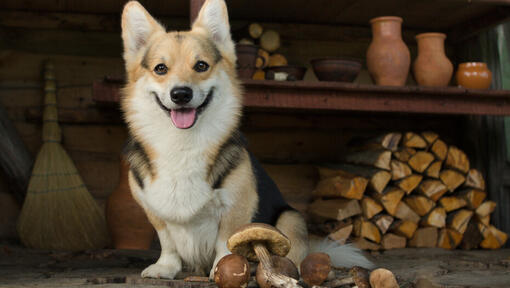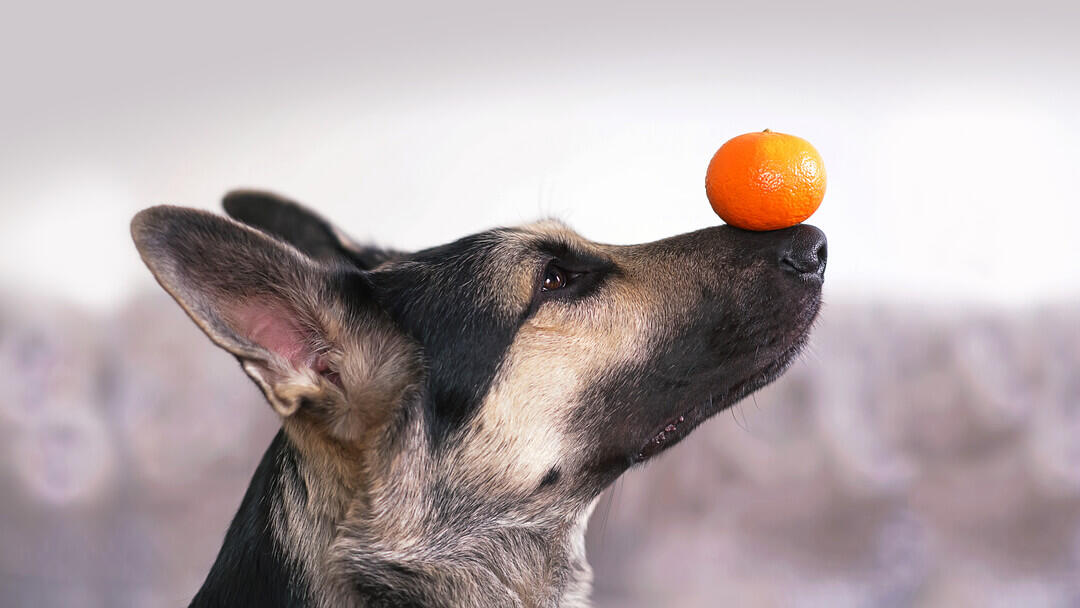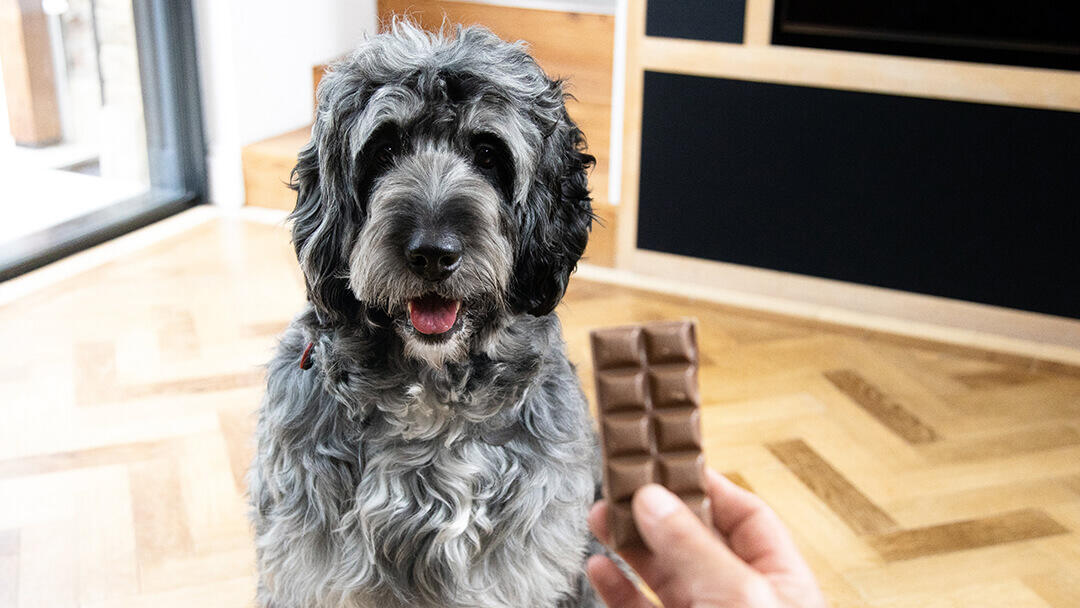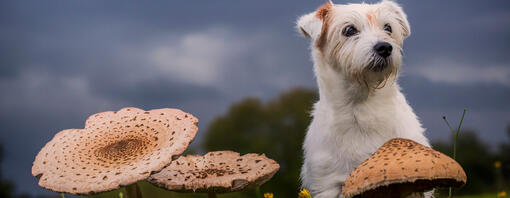
Mushrooms are making their way into more meals in recent years, but can your dog enjoy a nibble on fungi too? Find out if dogs can eat mushrooms and which ones to avoid in our guide.
You may have wondered “can dogs eat mushrooms? Especially when a straggler falls on the floor whilst cooking or a dog gives you puppy eyes as you tuck into dinner. At Purina, we’ve got all the information you need to know about if mushrooms are safe for dogs or not, and the low down on the varieties you should avoid. While some mushrooms are safe, it's important to note that they are not a necessary part of a dog's diet and should be offered in moderation. Find out if dogs can eat mushrooms in our guide below.
Can dogs eat mushrooms?
Similar to humans, some mushrooms are fine for dogs to eat, while others can be toxic. Dogs can eat mushrooms bought from a supermarket or other shop, preferably organic, unseasoned and raw. But you should always avoid any wild mushrooms. As there’s such a vast variety of mushrooms and they’re so difficult to tell apart, you should treat any wild mushroom with caution as some are incredibly poisonous. If you suspect your dog has eaten one, contact your vet as soon as possible.
If you spot wild mushrooms growing in your garden, you should remove them as soon as possible.
Can dogs eat cooked mushrooms?
Yes, dogs can eat cooked mushrooms, but it is rare that we cook mushrooms on their own! If we do want to give them to our dogs, it's important to ensure they are cooked appropriately and free from potentially harmful seasonings or additives. For example, shop-bought mushrooms cooked in a small amount of olive oil are fine for your dog to eat. However, mushrooms are often cooked with added extras such as onions and garlic along with added salt, which aren’t safe for your dog to eat and could potentially make them sick. Rather than giving your dog food from your plate, consider cooking mushrooms for them separately.
Here are some things to keep in mind when feeding your dog cooked mushrooms:
- Avoid harmful seasonings: Avoid adding onions, garlic, or other seasonings that can be toxic to dogs.
- Offer them in moderation: Mushrooms should be considered a treat and not a regular part of your dog's diet.
By following these guidelines, you can safely offer your dog cooked mushrooms as an occasional treat.
Are mushrooms bad for dogs?
As mentioned previously, dogs can eat mushrooms, raw and cooked. They contain vitamins B and D, minerals and antioxidants. They are also low calorie, have no fat or cholesterol and contain very little salt. They’re fine for your dog to eat, but you don’t have to give them as a supplement to their diet as your dog should get everything, they need from their complete, balanced dog food.
Varieties and Specific Characteristics of Safe Mushrooms for Dogs
Most options purchased in supermarkets are fine, such as the following:
- White button
- Cremini (white or chestnut mushrooms)
- Portobello
- Porcini
- Reishi
- Shiitake
- Maitake
Do not feed dried mushrooms of any kind (even after being re-constituted) as they can contain preservatives and additives that can cause allergic reactions or gastrointestinal upsets.
Wild mushrooms that are toxic to dogs in the UK:
A few wild mushrooms which are poisonous to both dogs and people are listed below along with their characteristics to help you spot them:
- Death Cap (Amanita Phalloides): Often pale green, yellow, or white with a smooth cap and a ring around the stalk. It can be easily mistaken for edible mushrooms like the field mushroom.
- Fly Agaric (Amanita Muscaria): This iconic mushroom has a bright red cap with white spots. It's often depicted in fairy tales but is highly poisonous.
- Deadly Webcap (Cortinarius Rubellus): This mushroom has a brown or reddish-brown cap and a slimy, sticky surface. It can be difficult to identify, as it resembles some edible mushrooms.
- Funeral Bell (Galerina Marginata): Small, brown mushrooms with a bell-shaped cap and a ring around the stalk. They often grow in clusters on decaying wood.
- Destroying Angel (Amanita Virosa): White mushrooms with a smooth cap and a ring around the stalk. They can be easily mistaken for edible mushrooms like the button mushroom.
- Fool's Funnel (Clitocybe Rivulosa): A funnel-shaped mushroom that is often white or cream-colored. It can be confused with other edible funnel-shaped mushrooms.
- Panther Cap (Amanita Pantherine): Similar in appearance to the Fly Agaric, but with a darker brown or gray cap and fewer white spots.
- Angel's Wings (Pleurocybella Porrigens): A small, white mushroom that grows in overlapping clusters on decaying wood. It can be difficult to identify, as it resembles other edible mushrooms.
If you're unsure whether a wild mushroom is safe or poisonous, it's better to assume it's poisonous and avoid it because some wild mushrooms can look very similar to the edible ones you find in shops. A good rule is to avoid letting your dog eat any mushrooms you haven’t bought as edible.
Symptoms of mushroom poisoning in dogs:
If your dog has eaten a poisonous mushroom, the symptoms can vary depending on the specific type of mushroom and the amount consumed. However, here is a more comprehensive list of symptoms to watch for:
- Drooling: Excessive saliva
- Vomiting: Repeated episodes of throwing up
- Diarrhoea: Loose and watery stools
- Abdominal pain: Restlessness, whining, or protecting the abdomen
In more serious cases:
- Collapse: Sudden loss of strength or ability to stand or walk
- Weakness: Difficulty walking or standing
- Organ (liver or kidney) failure
- Seizures: Loss of consciousness or muscle spasms
- Coma: A state of deep unconsciousness
- Dilated (enlarged) pupils
- Excessive thirst: Drinking more water than usual
- Difficulty breathing: Rapid or laboured breathing
To prevent mushroom poisoning, it's important to
- Avoid areas where wild mushrooms are known to grow: This is especially important during damp and rainy seasons when mushrooms are most abundant.
- Keep your dog on a leash in wooded areas or parks if there are mushrooms around or if they are known scavengers.
- Be vigilant and monitor your dog's behaviour after they have been outdoors – especially if they have been off-lead in areas where there are mushrooms.
- Consider using a muzzle to prevent your dog being able to eat and mushrooms they find on their walks.
If you suspect your dog’s eaten a wild mushroom, seek veterinary help right away. A speedy diagnosis and treatment are key in helping your dog recover fully and quickly.
How to feed mushrooms to your dog
If you want to give your dog a mushroom it’s best to stick to shop-bought, raw, organic options and never feed wild mushrooms that your find outside. They can be fed either plainly cooked or raw. Chop a small piece of mushroom and offer it to your dog, adjusting the amount based on their size and weight:
- Small dogs: Offer a quarter to a half of a small mushroom.
- Medium dogs: Offer a half to a whole small mushroom.
- Large dogs: Offer a whole small mushroom or a portion of a larger mushroom.
Remember that overfeeding mushrooms can lead to potential risks, such as:
- Gastrointestinal upset: Diarrhoea, vomiting, or abdominal pain.
- Allergic reactions: While less common, some dogs may be allergic to mushrooms and experience symptoms such as hives, itching, or difficulty breathing.
Mushrooms should be considered a treat and not a regular part of your dog's diet. Offer them as an occasional snack and always ensure they are plainly cooked or raw, organic, and free from any harmful additives. Be aware that not many dogs will enjoy the taste, so don’t be surprised if they turn their nose up!
Now you know that dogs can eat some mushrooms! Want to find out more about what dogs can and can't eat? Learn if dogs can eat celery, next.

